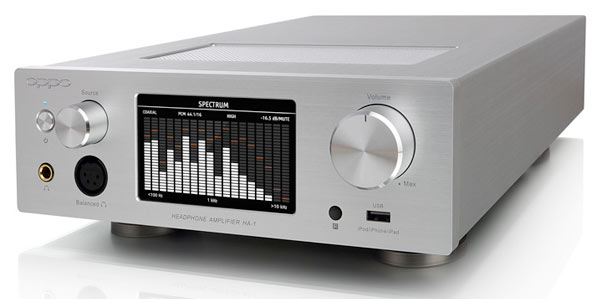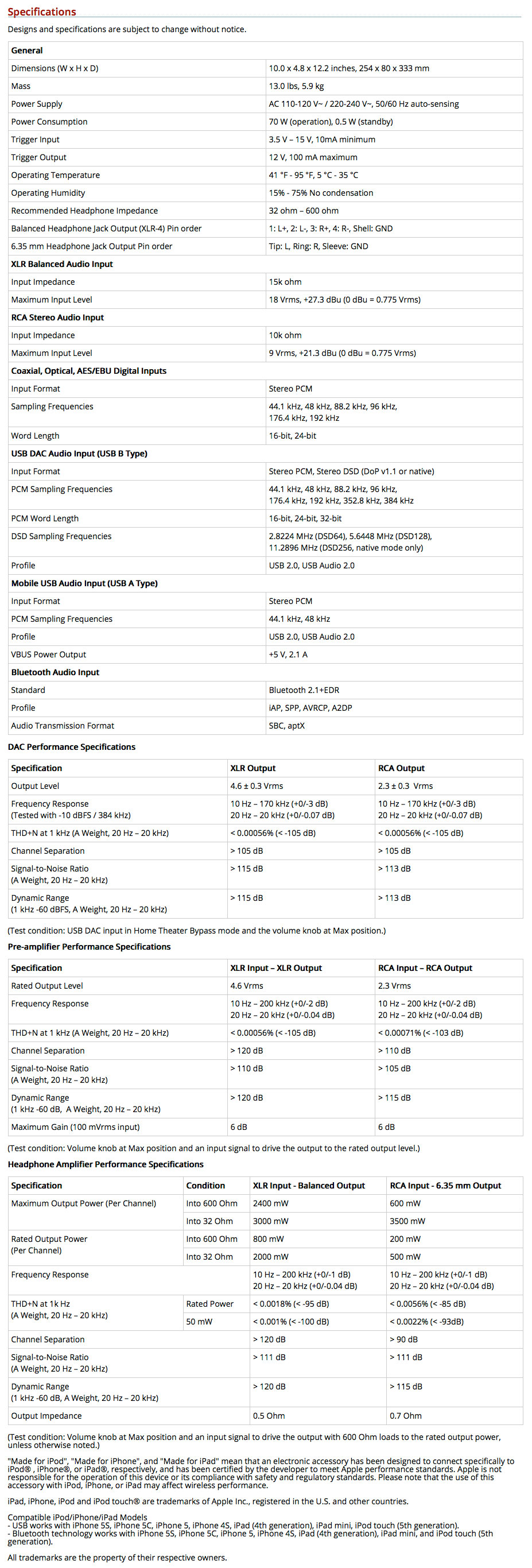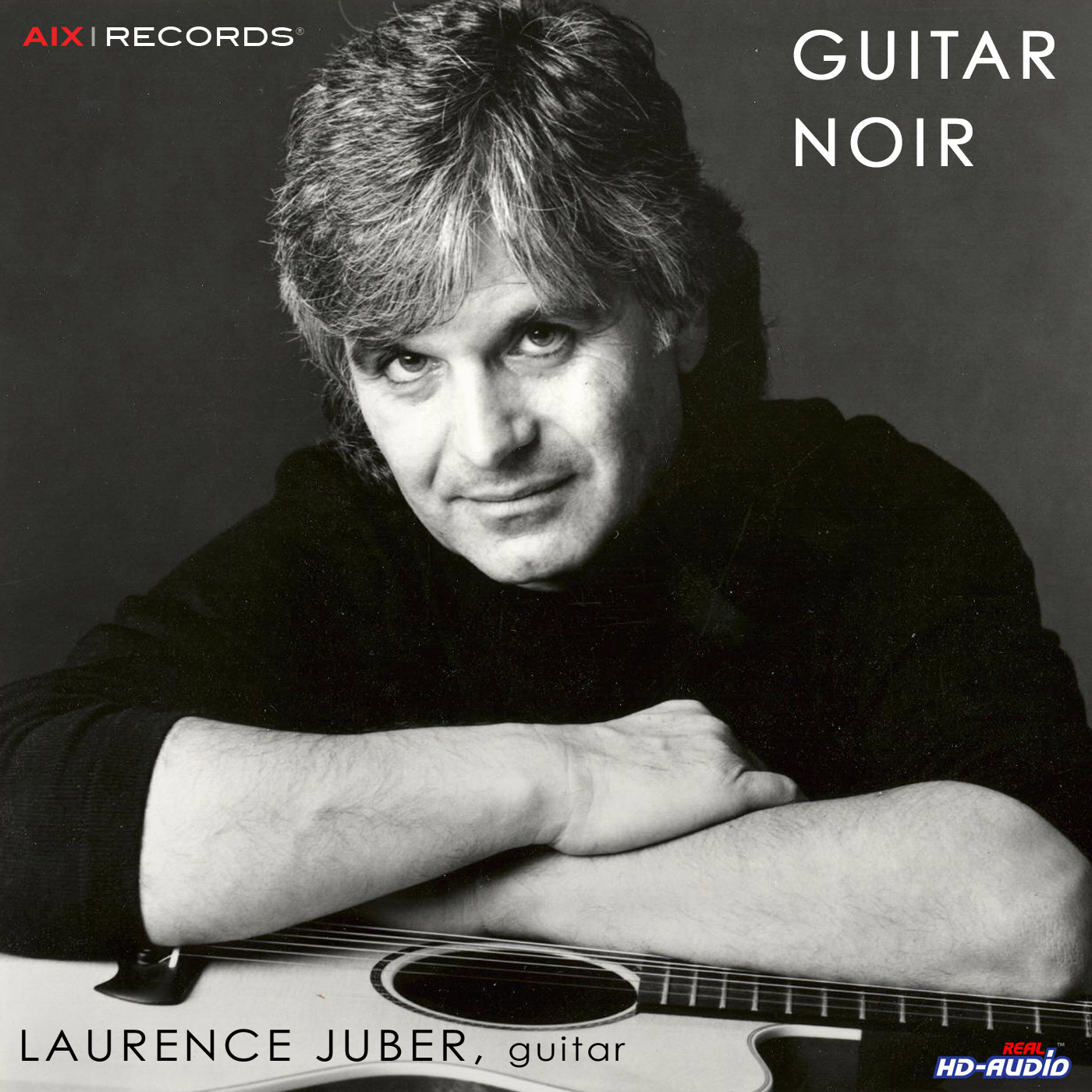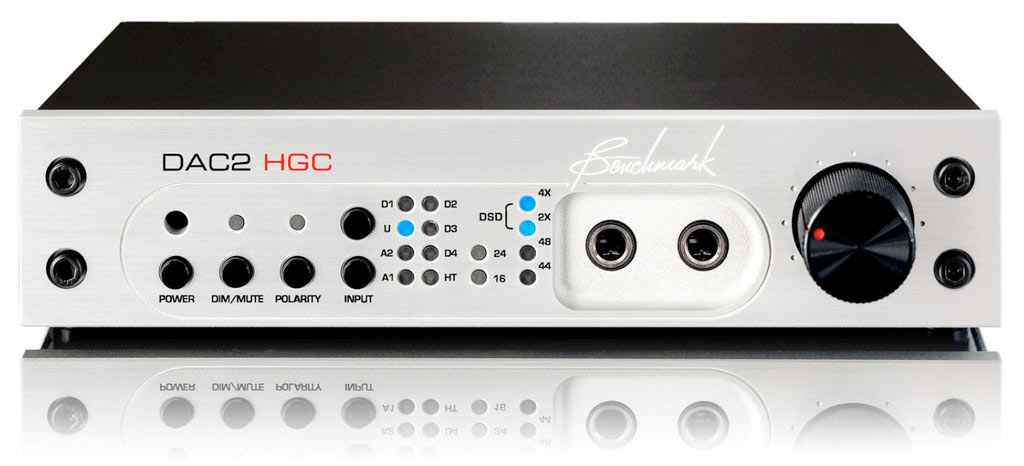Oppo Headphone Amplifier HA-1: Up Close 2
The Oppo HA-1 Headphone Amplifier is solidly built, easy to operate and features connectivity and flexibility far beyond its intended job of amplifying music for headphones. Yesterday’s lengthy post revealed all of the physical, electrical and operational workings of the HA-1. Today, I would like to continue with some specifications, a discussion of formats and express my opinion on the “sound” of the piece…using some of my high-resolution, stereo files.
Specifications and Formats
The HA-1 is built around the same design philosophy that has made the Oppo line of optical disc players the “must have” machines among budget…and sound conscious…purchasers. Central to this philosophy is that build quality, flexibility, reliability and fidelity are company priorities…with state-of-the-art technology at reasonable prices. The HA-1 features the ESS Sabre32 Reference DAC. This is same 32-bit DAC that is used in the BDP-95 and BDP-105 machines and many other first rate DACs. It delivers uncolored, neutral-sounding, decoded digital audio from both PCM sources and DSD, as well.
The specifications of the HA-1 cover virtually ALL of the available formats and sample rate/word length flavors including 44.1, 48, 88.2, 96, 176.4 and 192 for the AES/EBU, S/P DIF and TOSlink optical digital inputs and word lengths from 16 to 24-bits. These inputs can handle stereo PCM material.
If you choose to hook up the HA-1 to a “computer music playback unit” via the Type “B” USB connector you augment the list above with stereo DSD (DoP v1.1 or native), sampling rates of 352.8 and 384 kHz (rates that virtually no one is using to release music because and which are completely nonsensical!) and 32-bit words (again…no one is releasing files this way). For DSD fans (are any of my readers DSD fans?), the HA-1 is compatible with DSD 64, DSD 128 and DSD256.
The USB Type “A” mobile input on the front adopts the sonic limitations of the Apple line of “i” machines and specs out at stereo PCM at 44.1 and 48 kHz at 16-bits. This isn’t high-resolution now…but eventually it will be.
The Bluetooth wireless input uses compressed signals encoded as SBC or aptX. If you’re serious about audio quality, using the Bluetooth wireless input to this machine is not recommended. As good as SBC and aptX are…why not stick with uncompressed PCM at whatever sample rate and word length.
Without going into all of the specifications (see chart below) associated with the DAC and the analog preamplification circuitry, I can tell you that this unit boasts very good numbers. They aren’t off the chart, but should make any audiophile very happy. There’s always room to squeak another couple of dB in the signal to noise ratio spec by strapping several of the ESS channels together…but the HA-1 provides more than enough sonic clarity to please even the most discerning listener.
Figure 1 – The Specifications for the Oppo HA-1. [Click to enlarge]
Listening
I’m fortunate to have a high-resolution catalog at the ready to evaluate on the HA-1 AND I have both a great listening room and a set of Oppo’s PM-1 Planar Magnetic headphones at my disposal for quality listening. And after all of the specification sheets and features have been listed, isn’t this what matters most of all?
When I audition music on new equipment, I make sure to play tracks that I know very well. I use music that has tremendous dynamic range (well over the capabilities of CDs) and extended frequency range. It’s important to listen to a range of music genres including solo instrumental tracks, chamber music, vocal music, piano, orchestral and loud electric music. I pull up music on my Amarra powered Mac Laptop and use iTunes to navigate to tracks by Laurence Juber, John Gorka, Hanna/McEuen, the New Jersey Symphony Orchestra and Carl Verheyen.
The first track I auditioned on the HA-1 was my award-winning “Mosaic” by guitarist Laurence Juber, ex-Wings guitarist and finger style virtuoso (he’s well know for playing in the DADGAD tuning!). The “Mosaic” track (which is available as a download in both HD and CD resolution from the FTP site) is played by a trio of musicians. LJ plays his signature model Martin accompanied by Steve Forman on percussion and Domenic Genova on acoustic bass. This is the perfect track to use when testing new playback equipment. It’s got incredible dynamic and frequency range. There is a moment about two minutes into the track when Steve runs his fingers across a wind chime constructed of the tuning pins from a junked piano. It is the highest frequency music I’ve ever recorded and it taxes systems to the max. This is a sound that vinyl and analog tape AND DSD can’t realistically reproduce…with the same clarity and accuracy.
Figure 2 – The front cover of Laurence Juber’s “Guitar Noir” containing “Mosaic”. [Click to enlarge]
I listened first in the studio using my B&W 801 Matrix III speakers. The HA-1 was smooth, clear and fully capable of handling all of the challenges of that track. Through the PM-1 headphones, the same result. I played the track at low volume and then turned it up and got the same clarity and richness of sound.
Next on the playlist was the last movement of the “Pines of Rome” by Ottorino Respighi. The NJSO performed “The Pines of the Appian Way” for AIX way back in 2001 and it remains one of my favorite classical recordings. This orchestra has won a Grammy and despite playing second fiddle to the orchestra across the river in Manhattan has a youthful energy and sense of commitment that works well with high-resolution audio recording (It was a real struggle to make the recording happen but it turned out great!). The “Appian Way” movement spans a dynamic range from quiet pulsing pianissimo timpani strikes to a full blown orchestral tutti at the finish. This is crowd pleasing classical music. The triangle soars over the top while the timpani and brass play fortissimo and more.
I also listened to my favorite vocal tracks from Lowen & Narvarro, Hanna/McEuen and John Gorka. The “Lowlands” track from “Brand New Opry: Another Time” sounded rich and completely accurate to the original. This duet is among my favorites because there’s no drums or percussion to distract from the organic sound of guitars, banjo, fiddle, mandolin and acoustic bass.
The HA-1 is a terrific “headphone amplifier” and much, much more. The physical piece is solid, easy to use and would be a welcome addition to any listening environment. It’s flexible and can handle just about anything you want to amplify or convert from digital to analog. As for sound quality, several readers have asked me how it stacks up against my Benchmark DAC2 HGC. I can say that I love both but…
The Benchmark DAC2 HGC is a reference quality converter and functions as well as a preamplifier. It competes…and wins…against anything at any price, including the Light Harmonic $20K DAC (no kidding). The HA-1 is a notch below the rarefied air that Benchmark and others occupy. But a solid piece none-the-less.
Figure 3 – The Benchmark DAC2 HGC…the ultimate fidelity high-resolution PCM/DSD DAC. [Click to enlarge]
The Benchmark is somewhat more complicated to use because there is no main display…just buttons to access the multiple functions. So the HA-1 has some benefits in the user interface area over the Benchmark. But if you have to have the ultimate in digital to analog conversion, the DAC2 is the way to go…but it’s going to cost you $800 more.
Oppo has developed a winning strategy in a variety of products. The new HA-1 and their PM-1 headphones are going to be winners as well. Oppo understands the basics. If you design and build a quality piece, price it right, stand behind it and make sure that it sounds great…word of mouth will create the kind of buzz that everyone hopes for…and drive sales forward.
These guys are on a roll.





No disclaimer? Doubt I’ll ever take you seriously again.
Not sure what disclaimer you are suggesting should be present. I reviewed the product and believe it’s a great item. I don’t receive compensation or ad dollars from Oppo or Benchmark. I believe in their products.
The performance per price of this product is mind boggling, especially if you compare with other headphone amplifiers and DACs.
The reason why this DAC/amp combo has sold out in a single day.
“(are any of my readers DSD fans?)”
Um…. Yes, despite your attempts to scare us away. See you at Newport in a few weeks.
Russ
Hey Russ, the facts can be scary! See you soon.
This comment is really about AIX recording of the New Jersey Phil playing Pines of Rome. Anyone who is dubious because of the name of this orchestra should check out the recording. The playing is of the highest caliber. As a clarinetist, I can tell you that the clarinet solo in the third movement, one of the most demanding in the literature, is performed to perfection. I suspect these guys don’t just play for the New Jersey Phil, but really don’t know anything about them, except that they are terrific. Of course, so is the recording.
Thanks for the endorsement Stewart. Yes, the NJSO is a first class orchestra. I was thrilled at the performances after we sorted out some technical problems on the first day.
Hey Mark,
Just wondering if you have heard of the Lampizator dacs out of Poland and specifically how you feel the gen 4 dac stacks up against the Benchmark HGC?
Thanks
I can’t say that I’ve heard the Lampizator. I will reach out to them and see if they’d be willing to send me a unit. Could be interesting.
Hi Mark,
Wow did AIX and the HRA topic get featured on Home Theatre Review in today’s issue! I can’t wait to hear your response. There should be enough to “chew” for several days.
Jack.
Jack…I looked and don’t see anything. Can you send me a link?
Have to agree.
Oppo might be good, but to waste 2 days on promoting that stuff stinks. Have a nice life.
Sorry, you didn’t appreciate the review…others were asking for it. Be patient Frank…there’s lots of days in a week.
mark, your fiio x3 or x5 does the same as this device and costs 4x less….
The fiio units are very nice but not even in the same league as the Oppo piece, sorry.
based on what? the fiio sounds and measures terrific. have you done abx or blind testing?
The Fiio doesn’t have class A amplification as far as I know…and that makes a huge difference. I haven’t had my hands on one…no.
it may be class a. either way, it could make a difference, but its doubtfully huge if even perceptible…a test needs to be done….until than we have no reason to suspect meaningful difference except perhaps the xlr outputs of the oppo or the portability of the fiio.
I would love to be able to test and evaluate every piece of gear and I have no doubt that the Fiio and the Dragonfly are terrific. But there are levels of quality among similar devices. I have a Meridian DVD-Audio player that is dramatically better than my other optical disc players.
Mark,
I don’t want to bring this up as a knock as I highly respect you and I have learned a lot from your podcasts and from your conversations with Leo on his podcast.
In one of the podcasts you mentioned that Benchmark gave you a Benchmark DAC2. Benchmark has a great reputation in the audiophile community but as a disclaimer that might help in reviews.
Now if I am mistaken and I most certainly can be, I could be wrong. I can go listen back this past few weeks and give you the podcast number. I like both products but still am not sure the $800 is worth the Benchmark brand or not and am still be twitched in between deciding here.
Again highly apologize for the accusation but I listen to you and Leo religiously and heard that statement which I may have misheard of course.
Thanks for all this great information.
John…I’m a professional engineer and have a lot of equipment in my studio. I’m not just a reviewer but a user of this equipment. I have a DAC1 from Benchmark (and my associate also purchased one several years ago) that I’ve used for many years to master CDs etc. The new DAC2 HGC was loaned to me so that I could check out the improvements in the area of high-resolution audio. It is a state-of-the-art piece. However, I receive no financial upside from Oppo, Benchmark, Amarra or anyone else. These are products that I believe in and an happy to support.
The Oppo is a great headphone amplifier and much more. The Benchmark is a reference piece.
Mark,
No worries. The conversation was with Scott Wilkinson and I believe he was the one who said he received the benchmark device it was not you. My very bad mistake. It was on his home theater geeks podcast. I listened to it today. Appreciate the focus on improved audio wish there were more of you.
Hi Mark, thank you for your review. I was planninh to buy the Oppo HA-1 to be used in the place of a NAD 1050. I have a Sonnos Connect and Rega turntable connected through a NAD PP4 phono preamplifier and was planning to add a CD player. I understand that I will need a power amplifier for the Oppo to drive my pair of Totem Dreamcatcher. Something like the Cambridge Audio Azur 651W or the Marantz MM7025 (Suggestions accepted). The Oppo looks like it has a better interface and obviously will be better to drive a nice pair of headphones. I am a novice still trying to learn all of this but do you think the Oppo would be a good fit for this setup? Thank you in advance.
The Oppo is an excellent choice for all of the reasons that you mentioned. It’s an elegant, great sounding box that is easy to use and nice looking.
Hello,
Can anyone here advice if the oppo HA-1 or any other DAC+Preamp combo can drive my Axiom Subwoofer to potential? EP-600 is the model.
I currently use the XSP preamp from Emotiva and it does not output a strong enough signal via XLR to drive my subwoofer. I need to bump up the volume significantly to get the sub to work properly.
Cheers